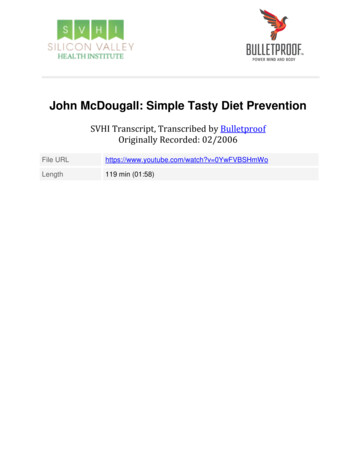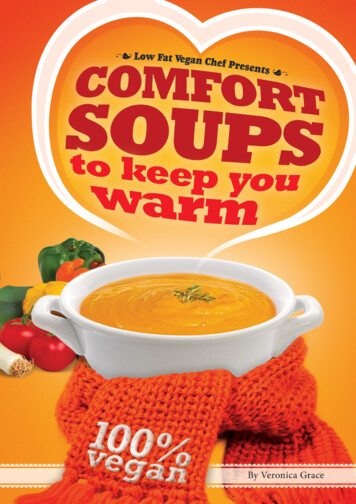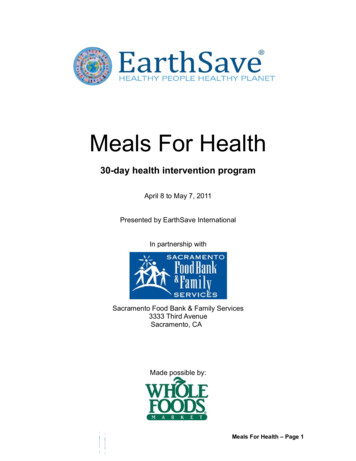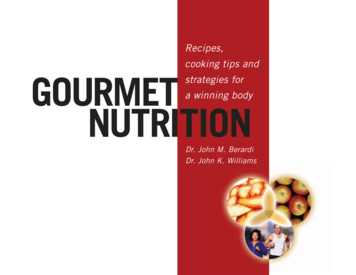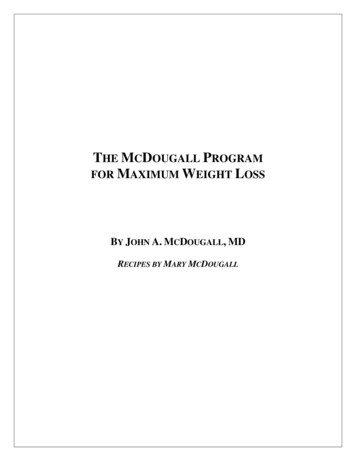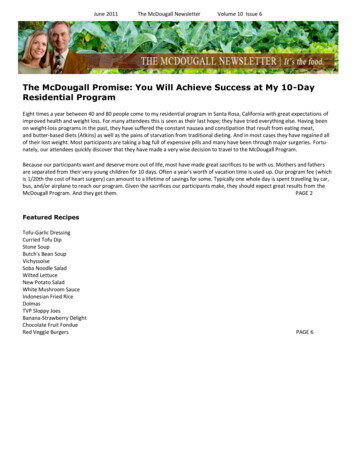
Transcription
June 2011The McDougall NewsletterVolume 10 Issue 6The McDougall Promise: You Will Achieve Success at My 10-DayResidential ProgramEight times a year between 40 and 80 people come to my residential program in Santa Rosa, California with great expectations ofimproved health and weight loss. For many attendees this is seen as their last hope; they have tried everything else. Having beenon weight-loss programs in the past, they have suffered the constant nausea and constipation that result from eating meat,and butter-based diets (Atkins) as well as the pains of starvation from traditional dieting. And in most cases they have regained allof their lost weight. Most participants are taking a bag full of expensive pills and many have been through major surgeries. Fortunately, our attendees quickly discover that they have made a very wise decision to travel to the McDougall Program.Because our participants want and deserve more out of life, most have made great sacrifices to be with us. Mothers and fathersare separated from their very young children for 10 days. Often a year’s worth of vacation time is used up. Our program fee (whichis 1/20th the cost of heart surgery) can amount to a lifetime of savings for some. Typically one whole day is spent traveling by car,bus, and/or airplane to reach our program. Given the sacrifices our participants make, they should expect great results from theMcDougall Program. And they get them.PAGE 2Featured RecipesTofu-Garlic DressingCurried Tofu DipStone SoupButch's Bean SoupVichyssoiseSoba Noodle SaladWilted LettuceNew Potato SaladWhite Mushroom SauceIndonesian Fried RiceDolmasTVP Sloppy JoesBanana-Strawberry DelightChocolate Fruit FondueRed Veggie BurgersPAGE 6
June 2011The McDougall NewsletterVolume 10 Issue 6The McDougall Promise: You Will AchieveSuccess at My 10-Day Residential ProgramEight times a year between 40 and 80 people come to my residential program in Santa Rosa,California with great expectations of improved health and weight loss. For many attendees thisis seen as their last hope; they have tried everything else. Having been on weight-loss programsin the past, they have suffered the constant nausea and constipation that result from eatingmeat, cheese, and butter-based diets (Atkins) as well as the pains of starvation from traditionaldieting. And in most cases they have regained all of their lost weight. Most participants aretaking a bag full of expensive pills and many have been through major surgeries. Fortunately,our attendees quickly discover that they have made a very wise decision to travel to theMcDougall Program.Because our participants want and deserve more out of life, most have made great sacrifices tobe with us. Mothers and fathers are separated from their very young children for 10 days. OfOften a year’s worth of vacation time is used up. Our program fee (which is 1/20th the cost ofheart surgery) can amount to a lifetime of savings for some. Typically one whole day is spent traveling by car, bus, and/or airplaneto reach our program. Given the sacrifices our participants make, they should expect great results from the McDougall Program.And they get them.Dr. McDougall’s Promise to ParticipantsOn the first evening, which is usually a Friday, people gather for my introductory lecture. Many appear tired, lost, and confused afafter their long day of travel. My welcoming remarks include firm statements onwhat they can expect over the next few days:1) I, Dr. McDougall, will personally care for each of you during the Program. Attending the 10-Day live-in Program is the only way I take on new patients. Once we commit to each other, I will be one of your doctors for our lifetimes.2) You will see objective improvements over the next week. These measurablechanges include a reduction in blood pressure, cholesterol, triglycerides, glucose,body weight, waist measurements, and/or medications taken. These numbers aredocumented. While improvements in bowel movements, oily skin, leg edema, andjoint swelling are consistently observed, these observed changes are not recordedwith any “hard numbers.”Those people who start with the most serious problems usually see the most dramatic changes. It is unrealistic, however, to expectto see decades of damage from an unhealthy diet and bad habits fully reversed in only a few days.3) You will also experience subjective benefits, such as the relief of headaches and body aches, and improvements in mobility andexercise performance. When medications are discontinued, the side effects are relieved.4) You will be able to eat as much delicious food as you want. Even so, most overweight participants will lose weight (see below).This is quite an accomplishment when you consider that the average weight gain on a seven-day cruise (eating the Western diet) iseight pounds.
June 2011The McDougall NewsletterVolume 10 Issue 65) You will love the food served at our program. This is true from the beginning for most participants. We serve very familiar dishessuch as “healthy” lasagna and chocolate brownies the first night, pizza for the firstlunch, bean burritos for the second dinner, and so on. However, for some peoplethe food is so unfamiliar that they do not enjoy it for the first few days. Tasteschange quickly, however, and often by the third day I hear, “The food is getting somuch better. Why didn’t you serve the shepherd’s pie or pasta and marinara saucethe first evening?” It’s simply a matter of adjustment. The focus of the Program is tomake healthful dietary changes permanent for you.6) You will stop taking unnecessary pills and shots. In most cases this means bloodpressure, type-2 diabetic, cholesterol, laxative, and antacid medications can be safely discontinued under medical supervision.7) I am a real medical doctor and I will write prescriptions for most of the additionalmedications that you might need during the Program. On those occasions, whetheror not you should be taking these pills is open for discussion between us, and together we will decide the right course of action.If you need medication, I will recommend those that are most effective, time-honored, safest, and least expensive. For example,the cost is 10 for 90 pills of thyroid supplements, diuretics for hypertension (chlorthalidone), and statins (pravastatin) for cholesterol at a discount pharmacy (Wal-Mart and/or Costco).8) By the end of the Program you will understand your overall condition and what needs to be done in order to achieve furtherbenefits after you leave. Imagine what you accomplish in the short time with us multiplied over the next several weeks andmonths. Three pounds of weight loss soon becomes 30 pounds permanently gone.9) A letter summarizing your 10-day stay with us will be sent to you shortly after the Program ends. This is an official record ofmedical discharge that you are encouraged to share with your doctors at home.10) The end of the 10 days* does not mean the end our relationship. I will be available to provide reasonable medical help to you. I have office hours almost everymonth in Santa Rosa, where we can have personal visits together. I am also readilyavailable by e-mail and phone (like you would expect from the new form of“concierge medicine” sold to people for three thousand dollars and more annually).* The actual Program includes nine overnight stays and measurements are made afull seven days apart. However, because it usually begins on a Friday and ends onthe following Sunday, we call this a 10-Day Program.Our Goal: The Best Vacation You Have Ever Had, But The most general and sincere promise I can make to you is that every one of our staff will work tirelessly to make this 10-day experience the best time and money you have ever spent. At graduation, usually the second Saturday evening of the program, I willremind you of the promises I made to you a little more than a week before. Fortunately, with extremely rare exceptions, thosepromises are kept. Usually, poor communication and unrealistic expectations cause disappointment. Here are a few of the mostcommon issues that are addressed during the Program:Issue # 1: “I didn’t lose enough weight.”The average weight loss over seven days is three pounds; that is almost half a pound a day. This number is an average, with some
June 2011The McDougall NewsletterVolume 10 Issue 6people losing more than 10 pounds in a week, which means others lose less. The entire staff is painfully aware that too little a loss,or even a gain, can be heartbreaking for people who came to lose weight (even when they see other remarkable changes, like a 50point drop in cholesterol and stopping three blood pressure medications). Our goal is not to see how many pounds (kilos) you canlose in a week, but for you to permanently lose your excess body fat. This can best be accomplished by teaching you a diet thatallows you to eat delicious and readily available foods to the full satisfaction of your appetite. Here are some of the reasons thescale may be unkind:1) We feed you exceptionally well. During the Program we want you to experience as many delicious foods as possible. Each lunchand dinner consists of a variety of 15 to 20 items, including a salad and two fat-freedressings, assorted cold vegetable salads, soup, raw and steamed vegetables, dishesof flavored rice, beans, and potatoes, and a cooked entrée or two. Most nights afterdinner, dessert is served. The service is all-you-can-eat buffet style. Because of theunrestricted eating that is available, some people—especially those with knowneating disorders—will over-stuff themselves. We teach a special maximum weightloss version of the McDougall Program to deal with these special needs.By the fourth day of the Program I hear, “I must be gaining weight; I have never eaten so much.” When we weigh people at this point most have actually lost weight,although often not as much as they were hoping for. I usually tell them during mynext morning’s lecture that the McDougall Program is not designed primarily as aweight-loss program. The Program is designed to permanently cure common diseases, and that the life-long loss of excess body fat is only a side benefit. If my programwere focused on losing as much weight as possible in the seven days between weighing, then I would portion the foods (one mainplate with a limited amount of brown rice and broccoli would be brought to your table by a waiter). As a last resort I threaten tocome in and cook the meals (I am a terrible cook).2) Many people have been on the McDougall Diet for months. Having already lost 20 to 75 pounds previously, the dining room ofoffers a feast compared to the simpler fare they were eating at home. Presented with this all-you-can-eat assortment, some peopleregain a couple of lost pounds. That is okay because they know the power of the Program.3) The repletion of glycogen stores can mean six added pounds. Because many other diets, such as semi-starvation and low-carb(Atkins-type) are lacking in carbohydrates, they deplete the body’s natural reserves of sugars, known as glycogen, stored in theliver and muscles. With re-feeding of a carbohydrate-abundant diet (the McDougall Diet) the body will, as expected, store twopounds of glycogen along with four pounds of water. Even though this is not body fat, and glycogen is stored invisibly, the weightshows up on the scale. Waist measurements that are done twice during the Program reassure people that they have lost fat andgained some muscle.4) Many people stop diuretics (taken for edema or high blood pressure) and gain one to four pounds of water weight.5) Women can gain several pounds of water weight with their menstrual cycle.6) Many attendees are already trim, or underweight, and appreciate the weight gain. An increase in appetite naturally happenswhen people begin to feel better and after medications with appetite-suppressing side effects are stopped.Issue #2: “My cholesterol did not come down.”We serve a no-cholesterol, very low-saturated-fat diet, so you would expect that the numbers obtained from the medical laboratory seven days apart would always show a reduction in this risk factor. The average reduction in blood cholesterol is 30 mg/dL in oneweek. Those with the highest starting values usually see the greatest reductions. Rarely, this number remains the same or rises. A
June 2011The McDougall NewsletterVolume 10 Issue 6rise is expected when cholesterol-lowering medications (such as statins) are stopped at the beginning of the Program.Triglycerides (blood fats) can go up significantly in some sensitive people. This happens especially when people eat large amountsof food and large amounts of simple sugars, including fruits and juices (we serve no juices at the Program). Type-2 diabetics whostop their insulin may also see this rise. With a significant rise in triglycerides, there can be an associated rise in cholesterol.I believe cholesterol-lowering medications (statins) are over-prescribed. In general, I recommend these medications only for peoat high risk of a stroke or heart attack. However, for people with a history of a heart attack, coronary heart surgery, TIA, or stroke,my usual goal is to lower their blood cholesterol to 150 mg/dL or less, and medications are often required. Otherwise, “healthypeople” should not be taking statins because they do not reduce the risk of heart attacks and death even with elevated numbers.Issue # 3: “My blood pressure did not come down to normal.”I try to stop blood pressure-lowering medications for most patients on their first visit with me (beta-blockers are reduced moreslowly). We monitor your blood pressure at least once a day. I must recommend this seemingly radical change in medications because my greatest fear is that with the change in diet and exercise at our Program people may become hypotensive (too low ablood pressure) and injure themselves (by falling).I believe blood-pressure-lowering medications are over-prescribed. I use the British Guidelines to start medication. In general, thismeans medications are prescribed when the blood pressure is sustained for months at a level of 160/100 mmHg or greater. Tooaggressive treatment, meaning reducing the diastolic blood pressure (lower number) below 85 mmHg with medication increases apatient’s risk of heart attacks and strokes. When medication is needed I try to first use the time-honored diuretic, chlorthalidone.Issue #4: I stopped all of my diabetic pills and my blood sugar is now worse.”I try to stop all diabetic pills and most of the insulin taken by people with type-2diabetes on our first visit. (With type-1 diabetes, insulin may be reduced but is nevstopped.) Sometimes the blood sugars fall and other times they rise with this medication change. You will be checking your blood sugar daily with your home monitorand report the results to our staff. I must recommend this seemingly radical changein medication because with the change to the McDougall Diet and increased exercise, people may become hypoglycemic (too low a blood sugar) and injure themselves (also by falling).In addition to dangerous hypoglycemic reactions, long-term aggressive treatment ofblood sugar in an attempt to achieve a normal blood sugar (measured by HgB A1clevels) causes an increased risk of heart attacks and death. In general, treatment ofblood sugar is required if the patient loses too much weight, develops symptoms ofdiabetes (such as excessive urination), and/or worries about the elevated numbers.Any of these developments suggest that the patient is not truly type-2, but suffers from an insufficient production of insulin by thepancreas. I use a long-acting variety of insulin (Lantus) as a once-a-day shot to treat when necessary.Issue #5: “I did not stop all my medications.”I make every reasonable attempt to eliminate all unnecessary medications on our first visit. This may seem radical to some newpatients meeting me for the first time, but most of the medications people are taking are not indicated according to “evidencebased medicine.” Plus the diet and exercise changes I prescribe will likely reduce your needs even further.I only have a short time to personally observe you during the Program in order to evaluate your responses and make adjustments
June 2011The McDougall NewsletterVolume 10 Issue 6in your medications. Therefore, I must make timely decisions. Most people leave my program taking no prescription medications.Many times having only one week is insufficient to make full adjustments in dosages and kinds of medications required. In thesecases your local doctors and/or I will help you make adjustments after leaving the Program. My final letter to you usually includesmy recommendations for future adjustments.My Program Is Your Best ChanceThe entire McDougall staff and I will make every reasonable effort to help you regain your lost health and appearance. Fortunately,the human body has a remarkable capacity to recover when relieved of the burdens of the rich Western diet and a lifetime of badhabits. Your realistic expectations should be met and you should expect to leave in much better shape then when you arrived.Most importantly, you will have hope for a brighter future and many more years of life to be lived to compensate for the short timeyou spent with us at the McDougall 10-Day Program.2011 John McDougall All Rights ReservedDr. McDougall's Health and Medical CenterP.O. Box 14039, Santa Rosa, CA 95402http://www.drmcdougall.comFeatured RecipesMost of this month’s newsletter recipes are variations of recipes found in The McDougall Health Supporting Cookbook Volume 1. These are a few more of our old favorites that I continue to make over and overagain because everyone loves them!Tofu-Garlic DressingThis has always been one of my favorite green salad dressings. If you don’t like cilantro, you can make this with only the parsley. This will keep in the refrigerator for about 5 days.SERVINGS: 2 cupsPREPARATION TIME: 10 minutesCOOKING TIME: none1 bunch parsley (about 2 cups clusters)1 bunch cilantro (about 1 cup leaves)2/3 cup water½ pound silken tofu4 cloves garlic2 tablespoons rice vinegar1 tablespoon soy saucePlace the water in a blender jar with the parsley and cilantro leaves. Process until finely chopped. Add remaining ingredients andblend until smooth. Serve as a dressing for salads or as a dip for raw vegetables. If you prefer to use this as a thick dip, add moretofu as you blend until desired consistency is obtained.
June 2011The McDougall NewsletterVolume 10 Issue 6Curried Tofu DipThis is wonderful on baked potatoes, or use it as a base for a curried potato salad. I also love it with asparagus and artichokes.SERVINGS: makes about 2 cupsPREPARATION TIME: 10 minutesCOOKING TIME: none (should be prepared at least 1 hour ahead so flavors can blend)1 package firm silken tofu2 teaspoons curry powder1 tablespoon parsley flakes1 teaspoon soy saucePlace tofu into a food processor. Add remaining ingredients. Process until well mixed. A small amount of water may be added tomake blending easier. Refrigerate until serving — at least 1 hour to allow flavors to blend.HELPFUL HINTS: This dip also makes a good salad dressing. Add water while processing until mixture is the desired consistency.Stone SoupI used to make this all the time to get my children involved in cooking and they always seemed to eat more when the cookingprocess was fun and they helped in the preparation. Now my grandsons love to chop and cook with me and they also seem toeat more when I get them involved in the process. This book was first published when I was a young child and is still availabletoday. For some reason, children love making soup with a stone. Try it with your children and get them to eat their vegetables!SERVINGS: 10PREPARATION TIME: 20 minutesCOOKING TIME: 60 minutes1 large very clean stone6 cups water3 large carrots, chopped3 potatoes, chopped2 onions, chopped2 stalks celery, chopped1 15.5 ounce can chopped tomatoes2 cups frozen corn2 cups frozen peas½ cup soy sauce½ cup whole wheat alphabet noodlesHeat water in a large pot. Add the stone. Add carrots, potatoes, onions, and celery. Cook over medium heat for 45 minutes. Addremaining ingredients. Cook for 15 minutes longer. Remove the stone and serve.HELPFUL HINTS: This is a fun way to introduce children to healthy eating. They will especially enjoy this if they help in the preparation. Our oldest children were 8 and 9 years old when they created this recipe after reading a book called Stone Soup. Stone is optional.Butch's Bean Soup
June 2011The McDougall NewsletterVolume 10 Issue 6Butch was one of our best friends back in our early years in Honolulu and on the Big Island. We reconnected recently and thefirst time I heard his voice on the phone I knew immediately who it was! This soup is one of his creations that we alwaysloved. It thickens as it cools and we like it spread on thick slices of whole wheat bread with lettuce and sliced fresh tomatoes.SERVINGS: 12-14PREPARATION TIME: 10 minutesCOOKING TIME: 4 hours (1 hour rest time)4 quarts water2 cups Great Northern beans1 cup small white beans3-4 onions, chopped½ cup lentils½ cup split peas½ cup barley1 teaspoon herb seasoning mix½ teaspoon curry powderBegin by placing the white beans (both kinds) in the 4 quarts of water along with the chopped onions. Bring to a boil, remove fromheat and let rest 1 hour. Return to heat and simmer for 2 hours. Then add lentils, peas, barley and spices. Cook for 1 hour longer.HELPFUL HINTS: This recipe makes a large amount of soup. Keeps well in refrigerator, reheats well, and also freezes well. Makes agood sandwich spread when cold.VichyssoiseI don’t often serve soups during the summer months, but this is one exception because it is meant to be served very cold. Makethis ahead of time and keep in the refrigerator until ready to serve.SERVINGS: 6-8PREPARATION TIME: 30 minutesCOOKING TIME: 1 hourCHILLING TIME: 2-4 hoursSoup:3 cups potatoes, peeled and chunked1 ½ cups chopped onions½ cup sliced leeks5 cups water½ teaspoon white pepper1 tablespoon soy sauceGarnish:Chopped parsley or chivesPlace all ingredients for soup in a large pot and simmer over medium-low heat until potatoes are very soft, about 1 hour. Blenduntil smooth. Chill. Garnish with chopped parsley or chives. Serve very cold.Soba Noodle Salad
June 2011The McDougall NewsletterVolume 10 Issue 6A very refreshing summer salad that I used to prepare year-round in Hawaii. Leftovers will keep for only one day without getting too soggy, so plan accordingly.SERVINGS: 4PREPARATION TIME: 20 minutesCOOKING TIME: 10 minutesCHILLING TIME: 1 hour8 ounces buckwheat soba noodles1 cup (dried) shiitake mushrooms1 cucumber, julienne sliced1 small head lettuce, coarsely grated3 green onions, chopped¼ cup fresh cilantro, chopped1 tablespoon shredded fresh ginger root2 teaspoons soy sauce1 teaspoon rice vinegar¼ cup waterCook soba noodles in 8 cups boiling water for 10 minutes. Drain, rinse, and chill. Place dried mushrooms in bowl, pour 1 cup boilingwater over them, let soak for 15 minutes. Squeeze to remove excess water. Cut off tough stems and discard. Slice mushrooms into¼ inch strips. Set aside. Prepare remainder of vegetables as directed. Combine all ingredients. Toss to mix well. Refrigerate untilserving time. Serve cold.HINTS: Fresh shiitakes may also be used in this recipe. Use about 1 cup sliced.Wilted LettuceMy mother used to make this all the time when I was a child because it was one of my dad’s favorites. I have to admit that I wasnot happy when this was on our dinner table in the evening because I was not fond of it back then. Now the combination of potatoes and lettuce is very appealing to us and this often makes a hearty, yet refreshing simple meal during the summer months.SERVINGS: 4PREPARATION TIME: 15 minutesCOOKING TIME: 15 minutes (need cooked potatoes)1 onion, chopped4 large cooked and peeled potatoes1 ¾ cups water¼ cup of apple cider vinegarSeveral twists of freshly ground black pepper1 large head lettuce, shredded½ cup chopped green onion (optional)Sauté the chopped onion in a small amount of water over high heat, stirring until it browns slightly. Mash the potatoes with a forkand add them to the onions. Add the water and the vinegar. Cook and stir until mixture is smooth and hot. Season with pepper totaste. Remove from heat.
June 2011The McDougall NewsletterVolume 10 Issue 6Put the shredded lettuce (and optional chopped green onion, if desired) into a large bowl. Pour the hot potato mixture over thelettuce. Toss well and serve at once.HELPFUL HINTS: This is a good use for leftover mashed potatoes — use about 2 cups. Taste the potato mixture as you are cookingit and add a bit more vinegar or water to get the proper texture and seasoning before pouring over the lettuce. It should be like athick sauce with no lumps and be slightly acidic in taste.New Potato SaladAnother of our favorite summer salads. Use any of your favorite oil-free dressings, or try this with the Tofu-Garlic Dressing orCurried Tofu Dip in this newsletter.SERVINGS: 6-8PREPARATION TIME: 30 minutesCOOKING TIME: 45 minutes½ pound mushrooms, cut in half or quartered2 tablespoons lemon juice10-12 red or white salad potatoes, cooked and cubed1 ½ cups cooked green beans½ cup celery, sliced1 bunch green onions, sliced¼ cup parsley, chopped2 tablespoons chopped pimiento¾ cup oil free salad dressingpaprikaCombine mushrooms with lemon juice. Toss to coat well. Add remaining ingredients and mix well. Refrigerate for several hoursbefore serving. Sprinkle with some paprika, if desired.HELPFUL HINTS: The potatoes may be cooked either with their skins on or without, depending on your preference. Other beans orvegetables may be substituted for the ones suggested above.White Mushroom SauceWe like this over whole wheat or brown rice spaghetti. When our children were younger we ate pasta frequently and this was anice change from the traditional red sauce.SERVINGS: 6-8PREPARATION TIME: 15 minutesCOOKING TIME: 30 minutes2 packages dried mushrooms, sliced OR 1 pound fresh mushrooms, sliced3 cups nut milk, rice milk or soy milk1 cup water1 onion, chopped½ teaspoons tarragon½ teaspoon dill weed½ teaspoon thyme
June 2011The McDougall NewsletterVolume 10 Issue 6¼ cup sherry or apple juice1 teaspoon soy sauce3 tablespoons cornstarch or arrowrootSoak dried mushrooms in warm water for 15 minutes. Squeeze out excess water and slice. Sauté onion in ½ cup of the water for 5minutes. (If using fresh mushrooms, sauté with the onions.) Add remaining ingredients, except for cornstarch or arrowroot. Bringto a boil over low heat, stirring often. Mix cornstarch or arrowroot in the remaining ½ cup water. Add to white sauce. Continue tocook and stir until thickened.Indonesian Fried RiceI always have plenty of leafy greens growing in my garden and I love curried food, so this is a perfect fast meal for a busy day.SERVINGS: 4PREPARATION TIME: 30 minutesCOOKING TIME: 15 minutes (need cooked rice)1 onion, chopped3 garlic cloves, peeled2 teaspoons curry powder2 stalks celery, chopped1 cup leafy greens, chopped½ cup fresh or frozen peas½ cup chopped green onions1 tablespoon soy sauce4 cups cooked brown rice½ cup chopped cucumberIn a blender jar, combine onion, garlic, and curry powder. Blend for 1 minute. (Mixture will be lumpy.) Set aside. In a wok or largepan, sauté celery in ½ cup water for 5 minutes. Add onion-curry mixture. Cook 2-3 minutes. Add greens, peas, green onions and soysauce. Cook and stir for about 5-10 minutes depending on greens used. Stir in cooked rice and heat through. Serve hot, garnishedwith chopped cucumber.HELPFUL HINTS: "Leafy greens" are spinach, mustard greens, watercress, kale, chard, beet greens, etc.DolmasThese take a bit of time to make but the results are so delicious that it’s worth the effort. These keep well in the refrigerator andmake a great snack food on hot summer days.SERVINGS: makes 48 dolmasPREPARATION TIME: 45 minutesCOOKING TIME: 1 ½ hours1 jar grape leaves (about 48 leaves)½ cup uncooked long grain brown rice2 cups finely chopped onion2 tablespoons finely chopped parsley2 tablespoons finely chopped mint leaves
June 2011The McDougall NewsletterVolume 10 Issue 62 teaspoons dill weed¼ cup pine nuts¼ cup currants¼ teaspoon black pepper1 cup tofu TVP (optional)Place grape leaves briefly in a pan of warm water to separate them, then drain on paper towels. Combine all other ingredients.Place grape leaf vein side up, with the stem toward you. Put a mound of rice mixture in the middle of the leaf (about 1 roundedteaspoon to 1 rounded tablespoon, depending on the size of the leaf). Fold over sides and roll up leaf. Layer the rolled leaves in alarge saucepan (3 quart) placing them side by side and close together. Press with a heavy heat proof plate that fits inside the pan.Add enough boiling water to cover leaves. Cover and simmer for 1 ½ hours.HELPFUL HINTS: Dolmas may be served warm or chilled. If warm, try serving them with lemon sauce. If cold, serve them with garbanzo puree or eggplant. The use of the tofu in this recipe is entirely optional, they are delicious both ways. The recipe for TofuTVP can be found in the May 2005 newsletter.TVP Sloppy JoesI make a big batch of this ahead of time and store in the refrigerator to reheat when necessary for a quick lunch or dinner. Iavoid using the commercially prepared TVP and prefer to make my own from frozen tofu. The recipe for detailed Tofu TVP preparation is in the May 2005 newsletter.SERVINGS: 10PREPARATION TIME: 15 minutesCOOKING TIME: 20 minutes2 cups tofu TVP1 onion, chopped1 green pepper, chopped¼ cup water½ cup ketchup1 tablespoon prepared mustard2 tablespoons apple cider vinegar2 tablespoons soy sauce¼ cup honey or agave nectar1 teaspoon chili powderCook the onion and green pepper in the water about 5 minutes until translucent. (Add a little more water if necessary). Add thetof
June 2011 The McDougall Newsletter Volume 10 Issue 6 The McDougall Promise: You Will Achieve Success at My 10-Day Residential Program Eight times a year between 40 and 80 people come to my residential program in Santa Rosa, California with great expectat
